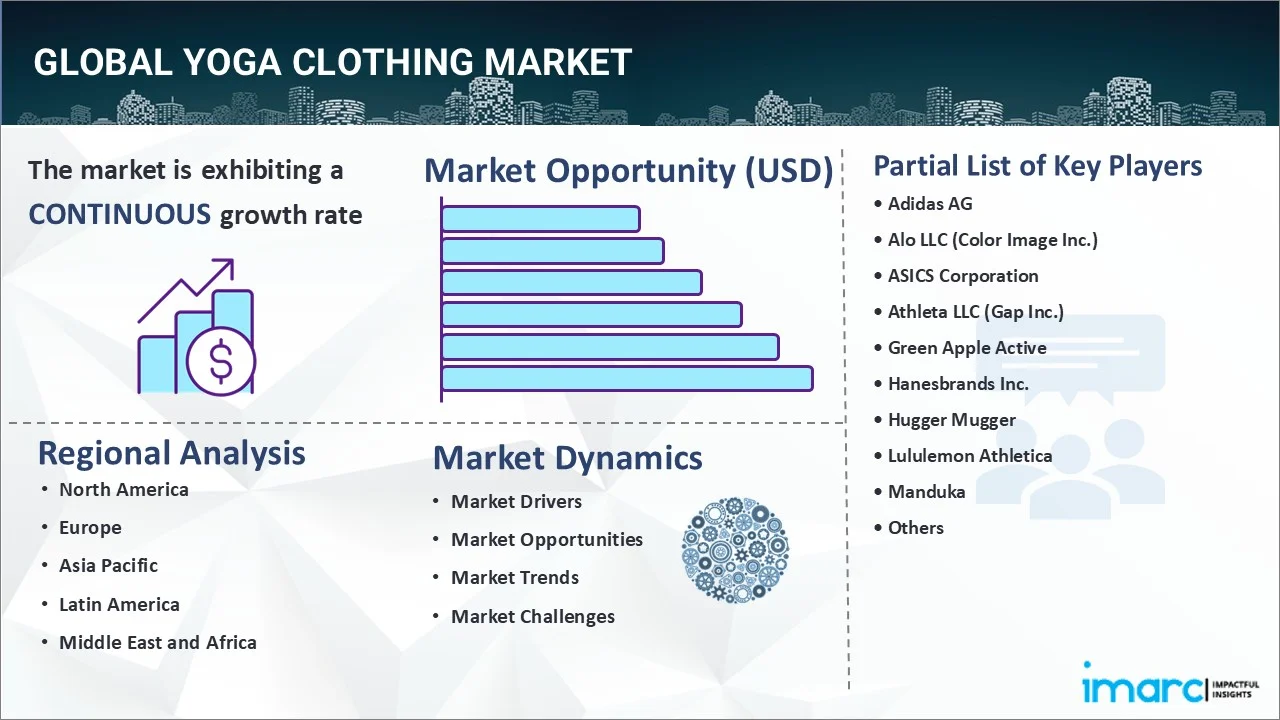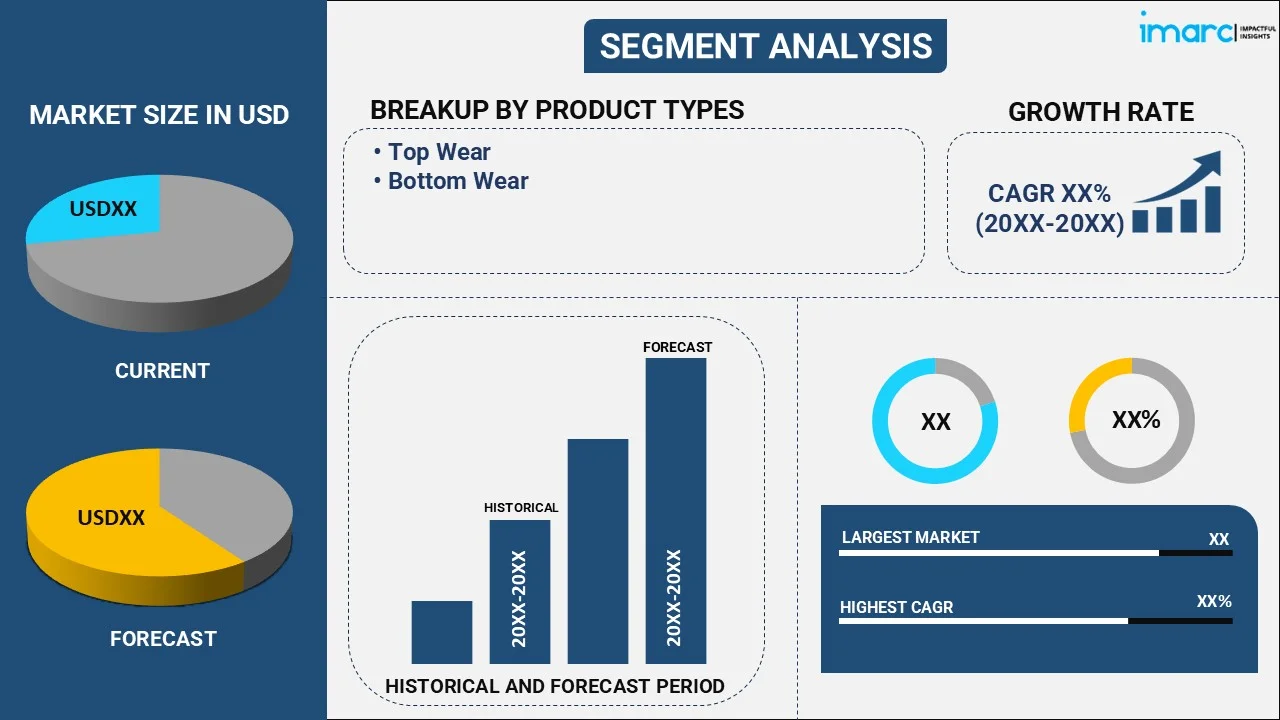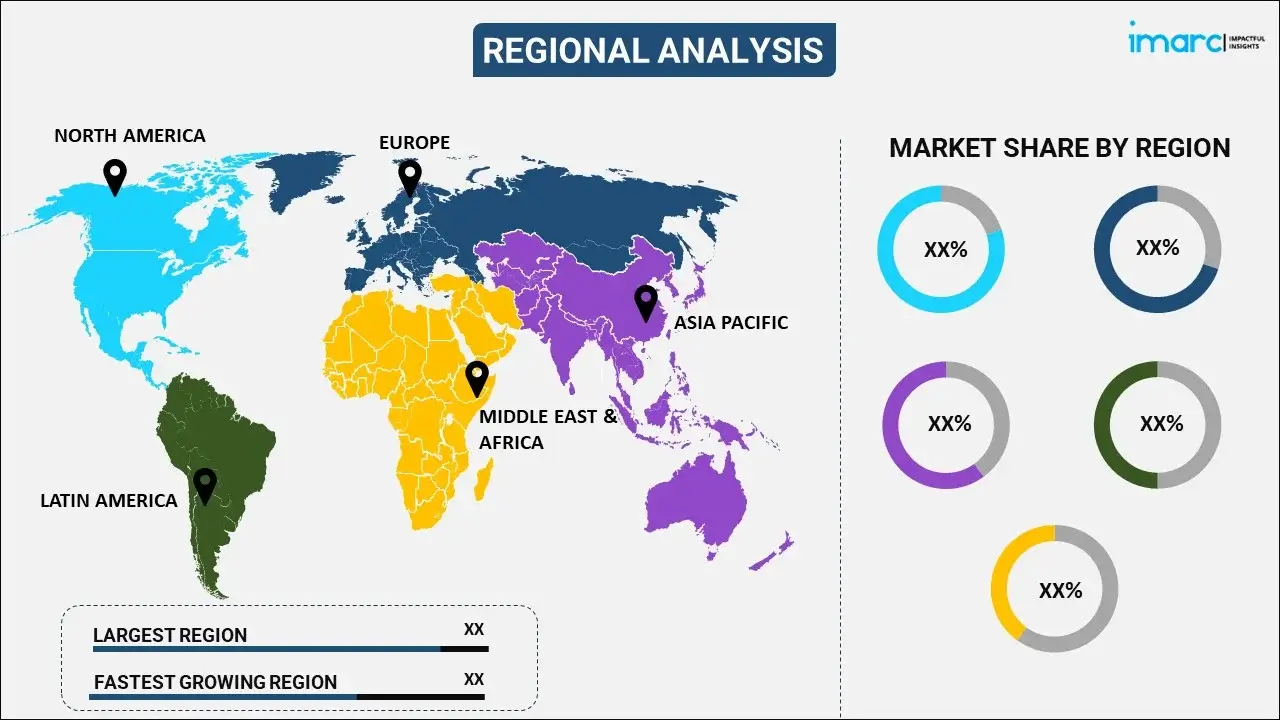
Yoga Clothing Market Report by Product Type (Top Wear, Bottom Wear), End User (Men, Women), Distribution Channel (Supermarkets/Hypermarkets, Specialty Stores, E-Commerce, and Others), and Region 2025-2033
Yoga Clothing Market Size:
The global yoga clothing market size reached USD 28.8 Billion in 2024. Looking forward, IMARC Group expects the market to reach USD 53.4 Billion by 2033, exhibiting a growth rate (CAGR) of 6.54% during 2025-2033. The rising health and wellness awareness, increasing athleisure trend, burgeoning participation in yoga, growing focus on comfort and performance, rising influence of social media and celebrities, and elevating number of specialty brands are some of the major factors propelling the market.
|
Report Attribute
|
Key Statistics
|
|---|---|
|
Base Year
|
2024 |
|
Forecast Years
|
2025-2033
|
|
Historical Years
|
2019-2024
|
| Market Size in 2024 | USD 28.8 Billion |
| Market Forecast in 2033 | USD 53.4 Billion |
| Market Growth Rate 2025-2033 | 6.54% |
Yoga Clothing Market Analysis:
- Major Market Drivers: The rising demand for specialized yoga clothing, supported by increasing health awareness, heightened focus on athleisure, and cultural endorsements, is bolstering the market expansion. Furthermore, the rapid advances in textile technology that enhance the functionality of yoga wear with features like moisture-wicking and stretchability to meet the specific needs of practitioners, is fueling the growth of the market.
- Key Market Trends: Social media platforms and celebrities significantly influence consumer preferences in yoga apparel, driving sales through endorsements and personal brand collaborations. Moreover, there is a growing trend towards eco-friendly practices in yoga clothing production, driven by consumer demand for sustainable products and brands' commitment to reducing environmental impacts.
- Geographical Trends: North America continues to dominate the yoga clothing market due to high yoga participation rates and the presence of major yoga apparel brands. Other regions are also showing growth, driven by increasing health consciousness and rising disposable incomes among consumers.
- Competitive Landscape: Some of the major market players in the yoga clothing industry include Adidas AG, Alo LLC (Color Image Inc.), ASICS Corporation, Athleta LLC (Gap Inc.), Green Apple Active, Hanesbrands Inc., Hugger Mugger, Lululemon Athletica, Manduka, Nike Inc., Prana (Columbia Sportwear), Puma SE (Artemis S.A.), and Under Armour Inc., among many others.
- Challenges and Opportunities: The market faces many challenges, such as market saturation that requires brands to innovate continuously to maintain consumer interest. However, opportunities lie in emerging markets as they present significant growth dynamics due to rising health awareness and urbanization. Moreover, the integration of more advanced technologies for comfort and performance, along with stylish designs that make yoga wear suitable for various social settings, is a promising trend for market growth.

Yoga Clothing Market Trends:
Rising Health and Wellness Awareness
Consumers are becoming conscious and aware of health and wellness, which is a main factor driving the yoga clothing demand. In the United States, 20% of young people aged between 2 and 19 years and 42% of adults are obese, which puts them at risk of heart disease, type 2 diabetes, and some cancers. This awareness has encouraged people to seek ways to better their physical fitness and mental well-being, and yoga has emerged as a popular choice. Yoga is known for its holistic approach to fitness which helps in promoting flexibility, strength, balance, and stress reduction. It is also estimated that nearly one in five people are daily smokers in the U.S., and one in five consumes a minimum of five alcoholic drinks a day at least once a year. These alarming habits have increased the importance of a yoga routine for most Americans and individuals across the globe. They are also recognizing the need for suitable clothing that allows them to move freely and comfortably during their yoga sessions.
Athleisure Trend
The athleisure trend has been blurring the line between activewear and everyday fashion, which has greatly influenced the yoga clothing market share. The increased desire for comfort and functionality in clothing has shifted consumer preferences toward versatile apparel that can be worn during workouts and in casual settings. The market for athleisure has been rising at a rapid pace, with a growth rate of 7.16% annually. It is also expected to touch US$ 49.9 Billion by 2032. Yoga clothing aligns perfectly with the athleisure trend because of its emphasis on stretchability, comfort, and stylish designs. People from around the world are choosing yoga pants, leggings, and tops for their yoga practice and as fashionable and comfortable attire for various activities throughout the day.
Increased Participation in Yoga
The increase in the number of individuals who are participating in yoga has directly impacted the product demand. Yoga has been gaining widespread popularity owing to its numerous physical and mental benefits. Many people are joining yoga studios, attending yoga retreats, and incorporating yoga into their daily routines. A study found that 11.8% of the Indian population practiced yoga. Among those, 14.4% of middle-aged and older adults in urban areas and 9.2% in rural areas practiced yoga and mindfulness activities more than once per week. Approximately 300 million people regularly practice yoga globally, and around 36 million Americans practice yoga regularly. In the past five years alone, yoga practitioners in the U.S. have increased by over 50%. As the number of practitioners grows, the need for appropriate clothing becomes essential.
Yoga Clothing Market Segmentation:
IMARC Group provides an analysis of the key trends in each segment of the market, along with forecasts at the global, regional, and country levels for 2025-2033. Our report has categorized the market based on product type, end user, and distribution channel.
Breakup by Product Type:

- Top Wear
- Bottom Wear
Bottom wear accounts for the majority of the market share
The report has provided a detailed breakup and analysis of the market based on the product type. This includes top wear and bottom wear. According to the report, bottom wear represented the largest segment.
As per the yoga clothing market analysis and forecast, bottom wear accounted for the largest market share. It provides the foundation for comfortable and flexible movement during yoga practice. Yoga poses involve stretching, bending, and balancing, requiring garments that allow unrestricted motion. Bottom wear, such as yoga pants and leggings, is specifically designed with stretchable fabrics that conform to the body and offer a wide range of motion. Additionally, bottom wear offers coverage and support. Yoga pants and leggings typically have a high-waisted design, which provides coverage and support to the waist and abdomen area.
Breakup by End User:
- Men
- Women
Women holds the largest share
A detailed breakup and analysis of the market based on the end user have also been provided in the report. This includes men and women. According to the report, women accounted for the largest market share.
Based on the yoga clothing market outlook and report, women clothing accounted for the largest market share, due to their higher participation rate. Additionally, women have specific preferences and considerations for their workout attire as they prioritize comfort, flexibility, and style in their clothing choices. In line with this, the introduction of designs that are tailored to cater to women's needs, offering a wide range of options such as yoga pants, leggings, tops, and sports bras in various styles, colors, and patterns, is fueling the yoga clothing market revenue.
Breakup by Distribution Channel:
- Supermarkets/Hypermarkets
- Specialty Stores
- E-Commerce
- Others
Specialty stores represent the leading market segment
The report has provided a detailed breakup and analysis of the market based on the distribution channel. This includes supermarkets/ hypermarkets, specialty stores, e-commerce, and others. According to the report, specialty stores represented the largest segment.
According to the yoga clothing market overview and trends, specialty stores dominated the market share as they cater to the needs of yoga practitioners, offering a wide selection of yoga clothing brands and styles. They focus on creating a curated shopping experience centered around yoga apparel, thereby providing a comprehensive range of options for customers to choose from. Additionally, specialty stores employ knowledgeable staff who are well-versed in the requirements and specifications of yoga clothes. They offer personalized recommendations, fit consultations, and advice on choosing the most suitable apparel for different yoga practices. Moreover, specialty stores create a sense of community and engagement for yoga enthusiasts by organizing events, workshops, and classes related to yoga.
Breakup by Region:

- North America
- United States
- Canada
- Europe
- Germany
- France
- United Kingdom
- Italy
- Spain
- Others
- Asia Pacific
- China
- Japan
- India
- South Korea
- Australia
- Indonesia
- Others
- Latin America
- Brazil
- Mexico
- Others
- Middle East and Africa
North America leads the market, accounting for the largest yoga clothing market share
The report has also provided a comprehensive analysis of all the major regional markets, which include North America (the United States and Canada); Europe (Germany, France, the United Kingdom, Italy, Spain, and others); Asia Pacific (China, Japan, India, South Korea, Australia, Indonesia, and others); Latin America (Brazil, Mexico, and others); and the Middle East and Africa. According to the report, North America represents the largest regional market for yoga clothing.
North America accounted for the largest market share for yoga clothing due to the significant rise in health and wellness awareness, with a growing population who actively seek ways to improve their physical fitness and mental well-being. In line with this, the rising adoption of yoga as a holistic approach to fitness, thereby translating into a higher demand for yoga clothing is favoring the market growth. Additionally, the increasing popularity of wearing activewear as everyday fashion, blurring the lines between workout attire and casual wear, is fueling the market growth. Furthermore, the well-established retail infrastructure, including specialty stores, department stores, and e-commerce platforms, that cater to the diverse needs of consumers, is bolstering the yoga clothing market growth.
Competitive Landscape:
- The market research report has also provided a comprehensive analysis of the competitive landscape in the market. Detailed profiles of all major companies have also been provided. Some of the major market players in the yoga clothing industry include Adidas AG, Alo LLC (Color Image Inc.), ASICS Corporation, Athleta LLC (Gap Inc.), Green Apple Active, Hanesbrands Inc., Hugger Mugger, Lululemon Athletica, Manduka, Nike Inc., Prana (Columbia Sportwear), Puma SE (Artemis S.A.), Under Armour Inc., etc.
(Please note that this is only a partial list of the key players, and the complete list is provided in the report.)
- The top yoga clothing companies are investing in research and development (R&D) to innovate and improve their yoga clothing offerings. They focus on developing fabrics with enhanced features, such as moisture-wicking, odor resistance, and compression. Additionally, major players are introducing new designs, patterns, and styles to cater to evolving consumer preferences. Besides this, they are engaging in strategic marketing and branding initiatives to create awareness and build brand loyalty by collaborating with yoga influencers, fitness professionals, and celebrities. Furthermore, key firms are also leveraging social media platforms, websites, and online advertising to engage with consumers and showcase their latest collections. Apart from this, they are expanding their distribution channels to make their products more accessible to consumers. They are establishing partnerships with specialty yoga stores, department stores, and online retailers to reach a wider customer base. Additionally, some players are opening their branded stores or e-commerce platforms to directly engage with consumers, thereby boosting the yoga clothing market recent developments and opportunities.
Yoga Clothing Market News:
- In September 2022, Puma launched a wide range of yoga wear collections, such as jackets, tops, and tights, that were manufactured using recycled materials like certified polyester and cotton.
- In July 2020, Lululemon Athletica announced the acquisition of MIRROR, a fitness brand, for $500 million. This acquisition allowed the company to improve their digital and interactive skills and strengthen their roots in the yoga clothing market.
Yoga Clothing Market Report Scope:
| Report Features | Details |
|---|---|
| Base Year of the Analysis | 2024 |
| Historical Period | 2019-2024 |
| Forecast Period | 2025-2033 |
| Units | Billion USD |
| Scope of the Report | Exploration of Historical Trends and Market Outlook, Industry Catalysts and Challenges, Segment-Wise Historical and Future Market Assessment:
|
| Product Types Covered | Top Wear, Bottom Wear |
| End Users Covered | Men, Women |
| Distribution Channels Covered | Supermarkets/Hypermarkets, Specialty Stores, E-Commerce, Others |
| Regions Covered | Asia Pacific, Europe, North America, Latin America, Middle East and Africa |
| Countries Covered | United States, Canada, Germany, France, United Kingdom, Italy, Spain, China, Japan, India, South Korea, Australia, Indonesia, Brazil, Mexico |
| Companies Covered | Adidas AG, Alo LLC (Color Image Inc.), ASICS Corporation, Athleta LLC (Gap Inc.), Green Apple Active, Hanesbrands Inc., Hugger Mugger, Lululemon Athletica, Manduka, Nike Inc., Prana (Columbia Sportwear), Puma SE (Artemis S.A.), Under Armour Inc., etc. |
| Customization Scope | 10% Free Customization |
| Post-Sale Analyst Support | 10-12 Weeks |
| Delivery Format | PDF and Excel through Email (We can also provide the editable version of the report in PPT/Word format on special request) |
Key Benefits for Stakeholders:
- IMARC’s report offers a comprehensive quantitative analysis of various market segments, historical and current market trends, market forecasts, and dynamics of the yoga clothing market from 2019-2033.
- The research study provides the latest information on the market drivers, challenges, and opportunities in the global yoga clothing market.
- The study maps the leading, as well as the fastest-growing, regional markets. It further enables stakeholders to identify the key country-level markets within each region.
- Porter's five forces analysis assist stakeholders in assessing the impact of new entrants, competitive rivalry, supplier power, buyer power, and the threat of substitution. It helps stakeholders to analyze the level of competition within the yoga clothing industry and its attractiveness.
- Competitive landscape allows stakeholders to understand their competitive environment and provides an insight into the current positions of key players in the market.
Key Questions Answered in This Report
The yoga clothing market was valued at USD 28.8 Billion in 2024.
The yoga clothing market is projected to exhibit a CAGR of 6.54% during 2025-2033, reaching a value of USD 53.4 Billion by 2033.
The yoga clothing market grows due to increasing health consciousness, rising interest in fitness activities, and the popularity of comfortable, versatile athleisure wear. Innovation in fabric design, such as breathable and stretchable materials, enhances consumer appeal. Social media influence and celebrity endorsements also drive fashion trends in this segment.
North America currently dominates the yoga clothing market due to a strong fitness culture, high disposable income, and growing health awareness. The popularity of athleisure trends, presence of key brands, and widespread yoga practice further drive demand, making the region a leader in this apparel segment globally.
Some of the major players in the yoga clothing market include Adidas AG, Alo LLC (Color Image Inc.), ASICS Corporation, Athleta LLC (Gap Inc.), Green Apple Active, Hanesbrands Inc., Hugger Mugger, Lululemon Athletica, Manduka, Nike Inc., Prana (Columbia Sportwear), Puma SE (Artemis S.A.), Under Armour Inc., etc.
Need more help?
- Speak to our experienced analysts for insights on the current market scenarios.
- Include additional segments and countries to customize the report as per your requirement.
- Gain an unparalleled competitive advantage in your domain by understanding how to utilize the report and positively impacting your operations and revenue.
- For further assistance, please connect with our analysts.
 Request Customization
Request Customization
 Speak to an Analyst
Speak to an Analyst
 Request Brochure
Request Brochure
 Inquire Before Buying
Inquire Before Buying




.webp)




.webp)












